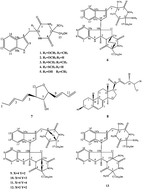Cytotoxic and antimicrobial indole alkaloids from an endophytic fungus Chaetomium sp. SYP-F7950 of Panax notoginseng†
Abstract
Two new compounds chetoseminudin F (1) and G (2) together with eleven known compounds were isolated from the solid fermentation products of the endophytic fungus Chaetomium sp. SYP-F7950. The structures of the isolated compounds were elucidated by extensive spectroscopic analyses, including 1D and 2D NMR, and HRFABMS experiments. The absolute configurations of chetoseminudin F (1) and G (2) were determined by comparing the electronic circular dichroism (ECD) spectrum with those of the reported references. A plausible biogenetic pathway for compounds 1–6 and 9–13 was proposed. These isolates were also evaluated for their antimicrobial and antitumor activity, revealing that chetoseminudin F (1) displayed more potent cytotoxicity against MDA-MB-231 cells with an IC50 value of 26.49 μmol L−1 more than the common chemotherapeutic agent (paclitaxel). In antimicrobial assay, compounds 6, 9, 11 and 12 had strong antibacterial activity against Staphylococcus aureus, Bacillus subtilis, Enterococcus faecium and antifungal activity against Candida albicans with minimum inhibitory concentration (MIC) values ranging from 0.12 to 9.6 μg mL−1; meanwhile compounds 6, 8, 9 and 12 exhibited strong cytotoxicity with IC50 values of 2.75–8.68 μmol L−1 against tumor cell lines A549 and MDA-MB-231. In addition, morphological observation showed that treatment with compounds 6, 9 and 12 increased the mean length of B. subtilis by 1.6 to 1.8-fold. In silico molecular docking was applied to study the binding interactions between the compounds and the active sites of filamentous temperature-sensitive protein Z (FtsZ) from B. subtilis. Compounds 6, 9 and 12 displayed the low binding energies, strong H-bond interactions with FtsZ. On the basis of the antimicrobial activities, cellular phenotype observation and docking studies, compounds 6, 9 and 12 are considered to be a promising antimicrobial inhibitor of FtsZ.



 Please wait while we load your content...
Please wait while we load your content...